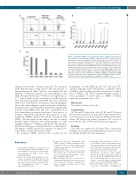Page 199 - 2021_03-Haematologica-web
P. 199
DKK1 long peptide for myeloma immunotherapy
AB
C
Figure 6. Dickkopf-1 (DKK1) -long peptide (LP) induces DKK1-specific human T- 3-76
cell responses from myeloma patients. Myeloma patient’s peripheral blood mononuclear cells were stimulated weekly with DKK13-76-LP plus IL-2 and IL-7 in vitro, and the frequency of DKK1-specific CD4+ and CD8+ IFN-g-secreting cells was detected by intracellular staining assay. (A) Representative results of T cells derived from a myeloma patient (MM1; HLA-A0201+ and HLA-DR*4+) and (B) sum- marized results from all ten myeloma patients at 4 weeks of in vitro stimulation. (C) Cytolytic activity of DKK1-specific T cells derived from MM1 against various tar- get cells including autologous (MM1) or allogeneic (MM2 and MM3) plasma cells, myeloma cell lines, B cells, and K562 cells. MM1 and MM2 are HLA-A0201+; MM3 is HLA-A1+ and A32+; U266 is HLA-A0201+, ARP-1 is HLAA0201-. Representative results from one of three experiments are shown. DC: dendritic cells.
synergy between the telomerase-specific Th responses with chemotherapy in lung cancer.26 The introduction of immunotherapy in clinical practice also emphasized the influence of immune responses on cancer prognosis and chemotherapy effectiveness.27,28 Politou et al.2 and Terpos et al.29,30 reported that serum concentration of DKK1 protein were increased in patients with MM and were correlated with severe bone disease. Autologous stem cell transplan- tation and chemotherapies with bortezomib, melphalan, dexamethasone and intermittent thalidomide significantly reduced serum DKK1 level and led to normalization of bone remodeling in relapsed myeloma. These pieces of evidence support the hypothesis that induction or aug- mentation of DKK1-specific Th1 cells by vaccination with DKK13-76-LP may improve the clinical outcome of cancer patients when combined with chemotherapy or other standard therapies.31,32 DKK13-76-LP-specific Th responses in MM patients may positively influence overall survival. The impact of DKK1-specific Th responses on clinical out- come will be evaluated in future studies.
In conclusion, DKK13-76-LP provides a useful tool for
propagation of both DKK1-specific Th1 cells and CTL, and may synergize with CTL-epitopes to enhance cancer cell killing. These findings provide a rationale for a clinical trial of DKK13-76-LP -based immunotherapy against a broad spectrum of cancer types, as DKK1 is widely expressed by human cancer cells.19
Disclosures
No conflicts of interest to disclose.
Contributions
JQ, RL and QY initiated the study. JQ, RL and CZ designed the experiments and wrote the paper; RL and JQ performed most of the experiments and statistical analyses; QW prepared human samples; EB helped with animal experiments; MY assisted in generating mice; JH and WF provided important suggestions.
Funding
This work was supported by Cleveland Clinic startup fund, VeloSano, the Leukemia and Lymphoma Society (6469-15), and the Multiple Myeloma Research Foundation.
References
1. Tian E, Zhan F, Walker R, et al. The role of the Wnt-signaling antagonist DKK1 in the development of osteolytic lesions in multi- ple myeloma. N Engl J Med. 2003; 349(26):2483-2494.
2. Politou MC, Heath DJ, Rahemtulla A, et al. Serum concentrations of Dickkopf-1 protein are increased in patients with multiple myeloma and reduced after autologous stem cell transplantation. Int J Cancer. 2006;119(7):1728-1731.
3. Kohn MJ, Kaneko KJ, DePamphilis ML. DkkL1 (Soggy), a Dickkopf family member, localizes to the acrosome during mam- malian spermatogenesis. Mol Reprod Dev. 2005;71(4):516-522.
4.HallCL,BaficoA,DaiJ,AaronsonSA,Keller ET. Prostate cancer cells promote osteoblas- tic bone metastases through Wnts. Cancer Res. 2005;65(17):7554-7560.
5. Qian J, Zheng Y, Zheng C, et al. Active vac- cination with Dickkopf-1 induces protective and therapeutic antitumor immunity in murine multiple myeloma. Blood. 2012; 119(1):161-169.
6. Zwaveling S, Ferreira Mota SC, Nouta J, et al. Established human papillomavirus type 16-expressing tumors are effectively eradi- cated following vaccination with long pep- tides. J Immunol. 2002;169(1):350-358.
7.Vambutas A, DeVoti J, Nouri M, et al. Therapeutic vaccination with papillo- mavirus E6 and E7 long peptides results in the control of both established virus-induced lesions and latently infected sites in a pre- clinical cottontail rabbit papillomavirus model. Vaccine. 2005;23(45):5271-5280.
8.Disis ML, Wallace DR, Gooley TA, et al. Concurrent trastuzumab and HER2/neu-
haematologica | 2021; 106(3)
845


